INTRODUCTION
Food safety is defined as a set of methods for handling, preparation, and storage of food aimed to preserve the quality of food to prevent contamination and food-borne illnesses [
12]. Interest in food safety has increased in tandem with the concern for boosting health for better immunity and the implementation of hygiene management for preventing the spread of infectious diseases such as coronavirus disease 2019 (COVID-19) [
3]. In other words, the outbreak of the COVID-19 pandemic can be regarded as one of the important factors affecting concerns about food safety. Among the various social changes brought about by the pandemic, the importance of choosing safe food is also being given an increased emphasis [
45].
Food safety can cause varying levels of anxiety among consumers based on a subjective evaluation of food safety [
6]. According to the Korea Rural Economic Institute (KREI), the subjective evaluation of food safety is described as “the degree to which one feels about the overall level of food safety in Korea assuming a 100 points score when food safety is perfectly managed.” [
7]. There are differences in the subjective evaluation of food safety according to the demographic and socioeconomic characteristics of the consumers. It was found that women and highly educated consumers displayed higher anxiety regarding food safety [
8]. Also, according to Kim
et al. [
9], the results of an analysis of how consumers evaluate food safety showed that they experienced higher anxiety about the safety of foods they consume (39.1%) than social anxiety (34.5%).
An increase in the frequency of occurrences of food-borne illnesses can lead to heightened consumer anxiety about food safety. Hazards that cause food safety incidents can be divided into 3 main categories; 1) microbiological hazards such as bacterial and viral pathogens, 2) chemical hazards caused by natural toxins or radioactive substances in food, and 3) physical hazards caused by a variety of foreign substances [
10]. Major food safety accidents that have occurred in Korea include the following: radiation detection in Japanese food following the Fukushima nuclear disaster (2011); coliform detection in cereal products (2014); the fake Baeksuo (Cynanchum wilfordii) incident (2015); and the scandal of naked kimchi made in China (2021) [
111213]. Major food safety issues that have occurred abroad include the following: incidents caused due to bacterial contamination of ingredients such as
Listeria,
Escherichia coli, etc.; incidents of exceeding the pesticide residue standard; problems due to packaging defects; and incidents due to improper labeling of allergens [
14].
Efforts are being made by the government and the corporate sector to preemptively prevent such food safety incidents. In the case of the government, this has taken the form of the enaction of laws and implementation of policies to enhance food safety. In 2010, the Ministry of Food and Drug Safety (MFDS), Korea announced the “Regulations on the scope, investigation, and procedure of foreign substances to be reported,” which requires business operators to report consumer complaints about the presence of foreign substances in food to administrative agencies [
15]. In addition, the “Imported Food Safety Management Special Act” was implemented to prevent harm to imported food and to maintain order at the distribution stage [
16]. Under the regulations on restaurant hygiene grade designation and operation management, the standards and evaluation items for assessing the status of restaurant hygiene are formulated and hygiene grades are designated through on-site evaluation [
1718]. Companies are also making an effort to abide by the regulations and are investing in the requisite facilities to ensure that food safety standards are met. Companies apply and operate under the “Hazard Analysis and Critical Control Point of Food and Livestock” (HACCP) for food safety management [
19]. Recently, various efforts have been made to develop and apply a food safety system through the use of smart technologies such as food poisoning bacteria detection using microfluidic chips, lab-on-a-disc (LOD), a food poisoning bacteria detection method applicable to automated technology, and paper-based analytical devices (PAD) [
20].
There have been several studies regarding consumer attitudes toward food safety and their willingness to pay extra to enhance food safety. Some studies on food safety have found that consumers attribute greater importance to food safety aspects such as quality certification and hygiene rather than the quantity, taste, or price of food [
82122]. Also, one study investigated the consumer characteristics that influence their perceptions [
823] and knowledge [
24] of food safety. In another study related to the subjective evaluation of food safety the extent to which consumers’ demographic and socioeconomic characteristics, etc., affect their subjective evaluation of food safety was investigated. There have also been studies about food safety and the willingness of the consumer to pay extra for safe food. According to a study that surveyed consumers' willingness to pay extra to ensure the absence of foreign substances in food, 56.8% of respondents said they were willing to pay extra to ensure food safety. The additional charges would compensate manufacturers who incur additional costs to reduce the occurrence of foreign substances in food [
25].
Food safety management is an expensive proposition. It is therefore necessary to incur costs commensurate with food safety pursuit behavior or the consumers’ intention to pay extra for safe food. Food safety pursuit behavior consciously reflects the pursuit of safety through behavior that preemptively anticipates and prevents food poisoning or food safety accidents [
2627]. The consumer’s intention to pay extra for safe food indicates a willingness to pay more for food to compensate for the increase in cost caused by the equipment or systems introduced to reduce the incidence of foreign substances in food material by the food producer and distributor [
2829]. It is, therefore, necessary to analyze the factors affecting the consumers’ intention to pay extra for safe food and to come up with a strategy to stimulate this willingness. However, few studies have analyzed the factors related to consumer characteristics in this context.
Therefore, the purpose of this study was to compare and analyze the involvement of consumers in food safety, subjective evaluation of food safety in Korea, and consumer willingness to pay extra for safe food according to their demographic and socioeconomic characteristics. The study further sought to evaluate the results according to the classification of consumers into various food safety interest groups. This study thus had 3 objectives; 1) to analyze the variations in the level of consumer involvement in food safety, carry out a subjective evaluation of food safety in Korea, and assessment of consumer willingness to pay extra for safe food according to their demographic and socioeconomic characteristics; 2) to analyze the differences in demographic and socioeconomic characteristics, carry out a subjective evaluation of food safety and willingness to pay extra for safe food according to the categories of food safety interest groups; 3) to investigate the factors affecting the willingness to pay extra for safe food according to the categories of food safety interest groups.
DISCUSSION
The purpose of this study was to compare and analyze the involvement of consumers in food safety, subjective evaluation of food safety in Korea, and the willingness to pay extra for safe food according to the demographic and socioeconomic characteristics of the subjects and to investigate the factors affecting the willingness to pay extra for safe food. Also, an analysis was undertaken of the demographic and socioeconomic characteristics, subjective evaluation of food safety in Korea, and the willingness to pay extra for safe food according to groups created based on levels of involvement in food safety. The conclusions of this study are as follows:
First, in the case of involvement in food safety according to demographic and socioeconomic characteristics, by sex, females (3.47) showed a higher involvement in food safety (P < 0.001) than males (3.36). By age, those in their 60s and over had the highest score of 3.48, and those in their 20s had the lowest score of 3.29 (P < 0.001). In terms of occupation, housewives showed the highest score (3.49), and other occupations showed the lowest score (3.36, P < 0.05). The group with a monthly household income of 3–4 million won had the highest score (3.52) and the 6 million won or more group had the lowest (3.34, P < 0.01). By administrative district, the level of food safety involvement was higher in the case of those living in a city area (Dong, 3.47) than those living in a rural area (Eup/Myon, 3.36, P < 0.05).
These results were similar to those of previous studies which revealed that women had a higher perception of food safety compared to men, housewives more than other occupations, and groups with an average monthly household income of 3 million won more than other income groups [
8]. In addition, in a previous study that confirmed the difference in knowledge levels regarding food safety according to demographic and socioeconomic characteristics, it was found that the groups of women, groups with an average monthly household income of 2 to 4 million won, and those comprising housewives had a high level of knowledge about food safety [
24], which are similar to the results of this study. According to Jung [
23], when college students purchase food, 46.6% give importance to food taste, and only 19.3% consider food safety as the main factor for their purchase decision. This is similar to the results of this study wherein people in their twenties showed relatively lower interest in food safety than other age groups.
Second, the subjective evaluation of food safety in Korea according to the demographic and socioeconomic characteristics was the highest in those aged 60s and over at 79.61, and lowest at 77.68 for those in their 30s. By age, there was a significant difference between those in their 30s to 40s and those in their 60s (P < 0.05). In the results of the analysis by educational background, the group of subjects who graduated from college and over scored higher (79.27, P < 0.05) than those who graduated from high school or lower (77.89).
The subjective evaluation of food safety in Korea in this study refers to the degree to which one perceives the overall food safety level in the country when a perfectly managed food safety score is 100 points. The subjective evaluation can be indicative of consumer confidence regarding food safety. In a study by Choe
et al. [
33], the group with the highest degree of anxiety about food safety among housewives was those with young household members and those with a higher-level educational background. A higher score in the subjective evaluation of food safety implies low anxiety about food safety. Since, in this study, the group of subjects who had a young household member showed a lower score, and the high education group received a high score, there is a difference from the study by Choe
et al. [
33]. Compared with the study by Lee and Lee [
34], this study had a similar result in that the group with a higher educational level displayed higher confidence in food safety. In the study by Jin
et al. [
35], it was observed that the residential area among the demographic and socioeconomic characteristics, satisfaction with the food labeling system, and the government’s food safety policy were factors affecting the subjective evaluation of food safety. The results of this study differed from the results of Jin
et al. [
35] due to a difference in the evaluation of food safety according to age and educational background. In a study by Lin and Lee [
36], it was observed that an increase in the subjective evaluation of food safety had a significant effect on overall dietary satisfaction. In other words, an increase in the subjective evaluation of food safety may increase confidence in, and satisfaction with food safety.
Third, in terms of the willingness to pay extra for safe food according to demographic and socioeconomic characteristics, males were more likely to pay more than females (P < 0.01), those aged 60 or more were more willing to pay extra than those in their 30s (P < 0.05), and those who were graduates from college or higher were more willing to pay extra than those who graduated from high school or lower (P < 0.05). Administrators, office workers, and professionals (P < 0.05), those with monthly household income levels of 3 to 4 million won (P < 0.01), and families having a young household member (P < 0.05) showed a higher willingness to pay extra.
According to Park
et al. [
37], it was found that the group with a high interest in health showed a greater willingness to pay extra when purchasing quality certified agricultural products. Also, this attitude had a positive (+) effect on the willingness compared to the group with low interest in health. Thus, it can be seen that subjects with a high interest in health were more willing to pay extra for quality food. Health interest was found to be high when the age, education, and income levels were high [
38], or when the subjects had children [
39]. The results of this study are different from those of previous studies since the 3 to 4 million won income group and families without a young member showed a higher willingness to pay extra.
Fourth, the demographic and socioeconomic characteristics, subjective evaluation of food safety, and willingness to pay extra for safe food according to the groups formed based on involvement in food safety levels were as follows: There were statistically significant differences in the sex (P < 0.001), age (P < 0.01), occupation (P < 0.001) and administrative district (P < 0.05) according to the involvement in food safety. In addition, the willingness to pay extra for safe food was relatively higher in the group with a high involvement in food safety than in the group with a low involvement, and this difference was statistically significant (P < 0.001).
In the study by Yoo [
40], the perception, response behavior, and satisfaction with regulations regarding genetically modified foods and food recall regulations were high in the ‘sensitive response’ group with the highest interest and involvement in food safety. High interest in food safety indicates that food safety was a prime concern of consumers while purchasing food [
826]. In other words, the level of food safety involvement can be seen as a measure of the overall perception of consumers when purchasing food.
Fifth, educational background, occupation, monthly household income, the existence of young household members, and food safety involvement were found to be the variables influencing the willingness to pay extra for safe food. In terms of demographic and socioeconomic characteristics, those with a high school diploma or lower showed a lower willingness to pay extra than those with a college degree or higher (β = −0.065, P < 0.05). In the case of those in a managerial/office/professional occupation, the willingness to pay extra was higher than those in other occupational groups (β = 0.108, P < 0.05). Compared to those who had an average monthly household income of 6 million won or more, those in the 3-4 million won (β = 0.108, P < 0.05) and the 4–5 million won (β = 0.097, P < 0.05) income groups had a higher willingness to pay extra for safe food. The willingness to pay extra for safe food was higher in the group with no young household members than in the group with a young household member (β = −0.327, P < 0.01).
The educational level, occupation, monthly household income, presence or absence of a young household member, and level of involvement in food safety explained 10.5% of the willingness to pay extra for safe food, and this model was thus found suitable (Wald F = 13.327, P < 0.001).
Meanwhile, the factors affecting the willingness to pay extra for safe food by the groups based on the extent of their involvement in food safety (defined as low or high) were as follows: The statistically significant variables were sex (β = −0.081, P < 0.05), age (β = −0.130, P < 0.05), and income level (β = 0.149, P < 0.05) in the group with low involvement in food safety. Education level (β = −0.087, P < 0.05), and the presence or absence of a young household member (β = 0.129, P < 0.05) were observed to be the statistically significant variables in the group with high involvement in food safety.
Chung
et al. [
28] studied the willingness to pay extra to reduce the incidence of foreign substances in food, and 57.3% of the respondents stated that they would pay extra for safe food. It was identified that more people had the willingness to pay more for food safety, but the factors affecting the willingness to pay extra were not researched. However, in this study, it was confirmed that educational background, occupation, monthly household income, the presence of young household members, and involvement in food safety were factors that affected the willingness to pay extra for safe food.
In a study by Yoo [
40], it was found that confirmation behavior levels with respect to food labeling, which provides a variety of information about the food, had a positive (+) effect on the willingness to pay extra. A high level of food labeling confirmation behavior indicates a high level of interest in food safety. This study had results similar to the study by Yoo [
40] as it showed that the level of involvement in food safety had a positive (+) effect on the willingness to pay extra.
The willingness to pay extra for safe food can be interpreted as the attitude of consumers who are willing to pay more if food prices rise due to the establishment of a safe food management system [
8]. Thus, it was observed that the attitude toward the willingness to pay extra for safe food varied according to the characteristics of the consumers. Therefore, in this study, the consumer characteristics influencing food safety involvement and the factors affecting the willingness to pay extra for safe food were derived.
The institution of government policies relating to food safety and the installation of systems for food safety management by the industry can result in a safe food production and distribution environment. However, this requires investment in facilities and equipment which increases costs for companies and thereby leads to an increase in product prices. Therefore, there is a need to change the attitude of the consumers to make them willing to pay extra for safe food. Thus, various consumer education and publicity programs should be formulated to improve consumers’ awareness of food safety and to induce interest in that direction. Specifically, food safety education that reflects consumer characteristics or publicity and campaigns involving public participation can be considered.
The academic implications of this study include the verification of the influence of various variables that can identify consumers’ characteristics, such as demographic and socioeconomic characteristics, perceptions of food safety, and food safety involvement. Specifically, the differences in involvement in food safety, which had the greatest influence on the willingness to pay extra for safe food, were verified for each group. This is believed to be a precedent study involving in-depth analysis that identified factors that can increase the willingness to pay extra for safe food according to the level of involvement in food safety. At the same time, this study has implications for the industry as it has analyzed various consumer characteristics regarding food safety perceptions and the willingness to pay extra for safe food.
The limitations of this study are as follows: Food safety variables such as involvement in food safety, subjective evaluation of food safety, and the willingness to pay extra for safe food, can be considered to be directly related to health. Therefore, in the future, a study on the relationship of the above with health-related variables is also required. In addition, it is necessary to provide inputs for the formulation of marketing strategies by companies by confirming the consumer intention to pay extra for each food item.
This study verified the demographic and socioeconomic characteristics, involvement in food safety, evaluation of food safety, and the willingness to pay extra for safe food, and it presents basic data for policy-making and cost budgeting to strengthen food safety management.
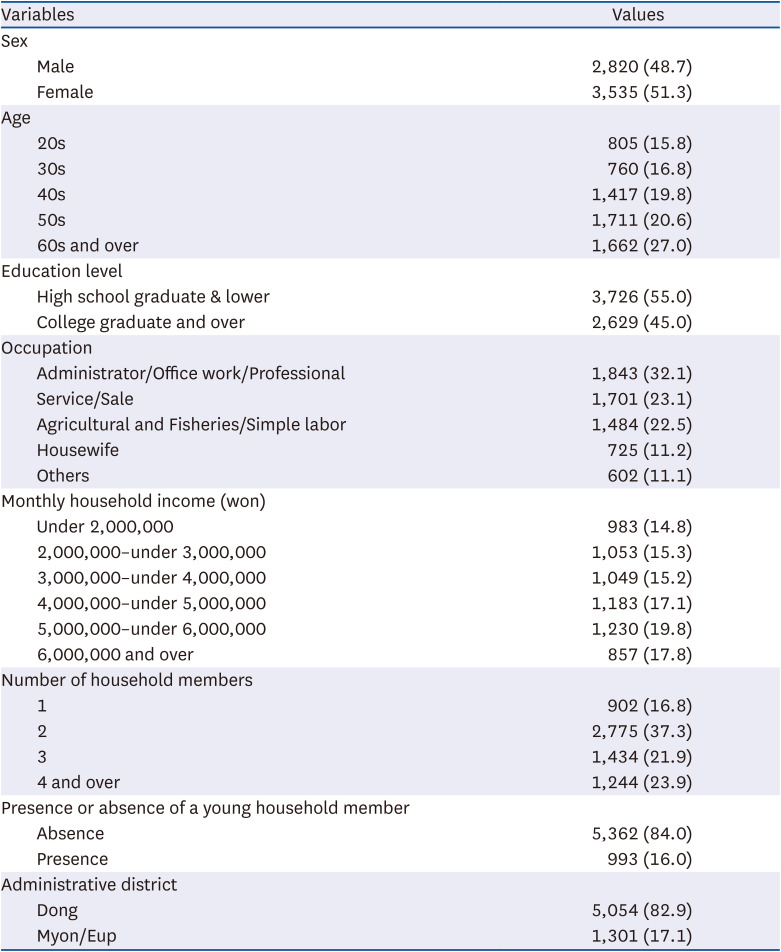
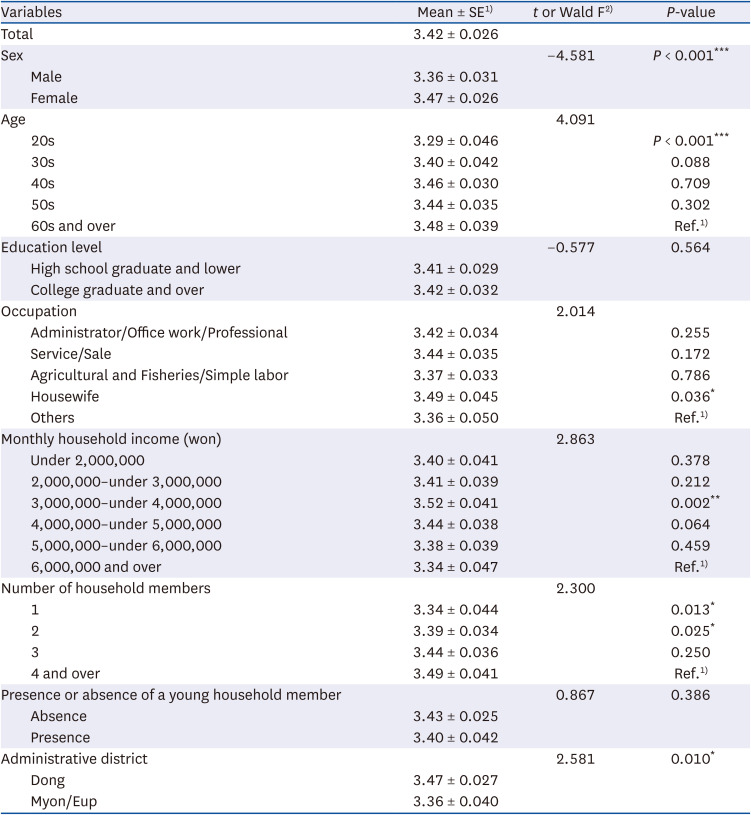
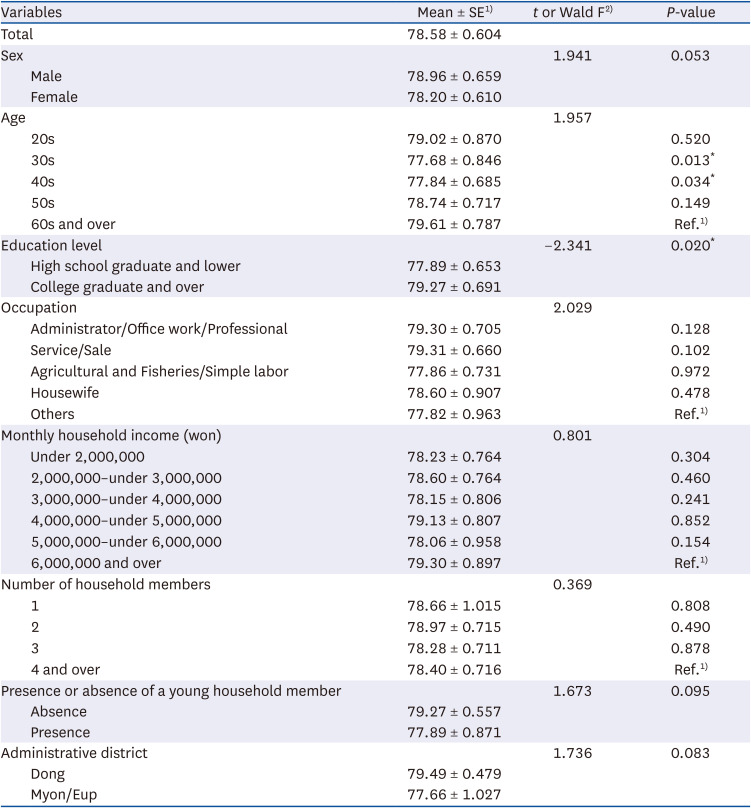
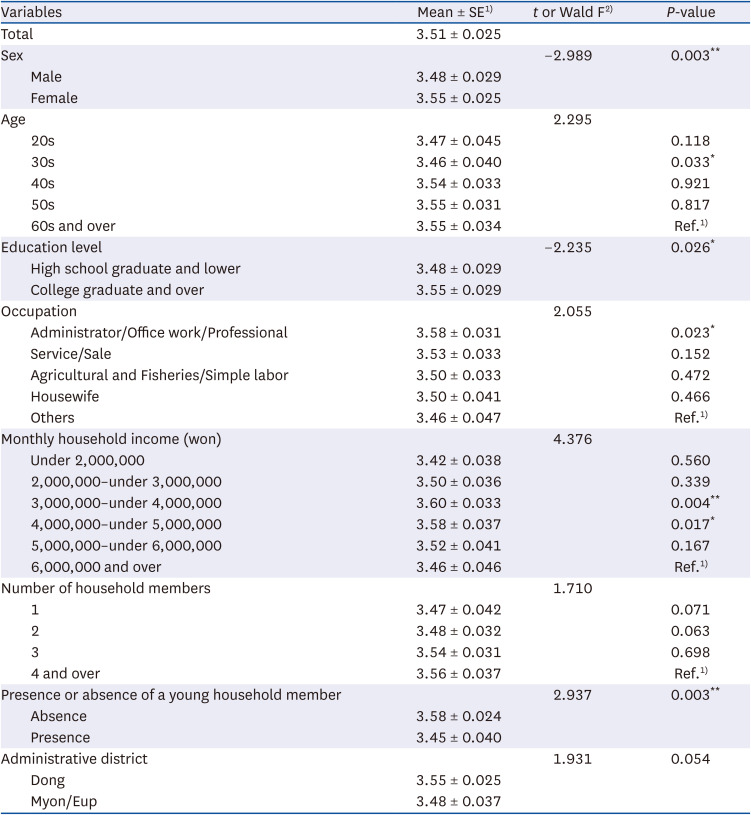
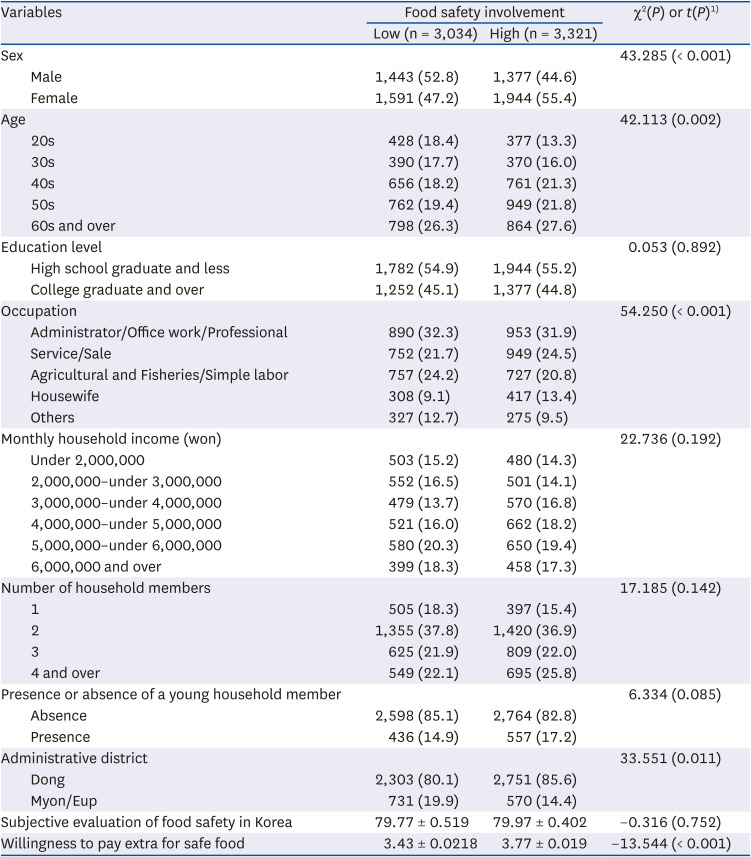
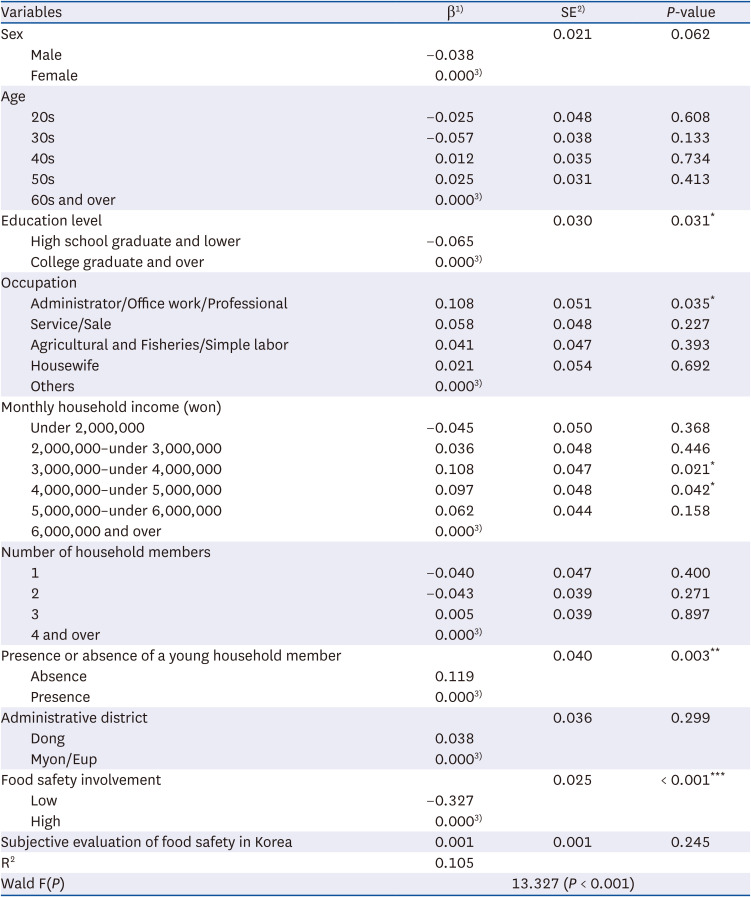
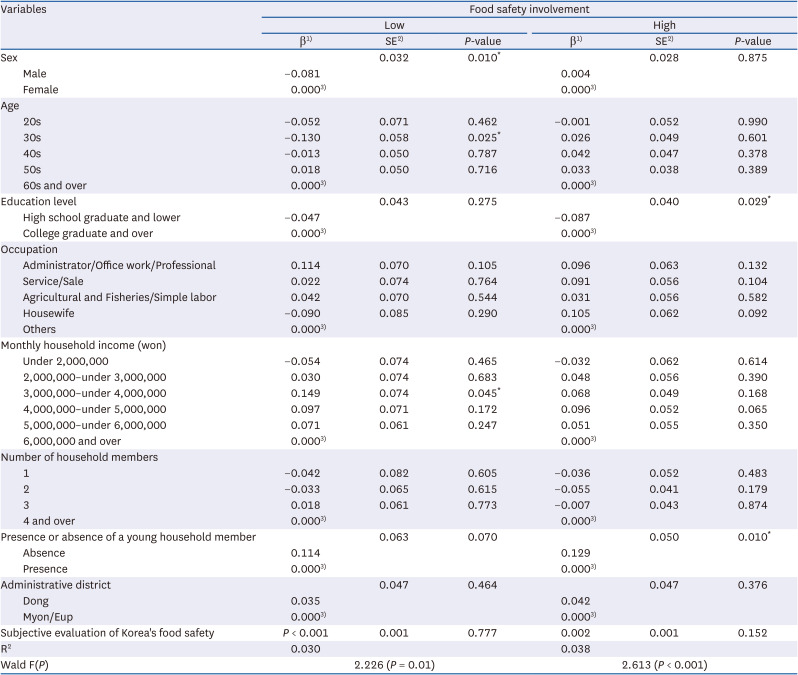




 PDF
PDF Citation
Citation Print
Print



 XML Download
XML Download